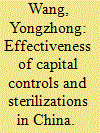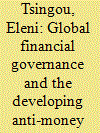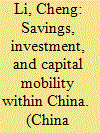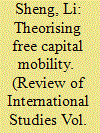|
|
|
Sort Order |
|
|
|
Items / Page
|
|
|
|
|
|
|
| Srl | Item |
| 1 |
ID:
098771


|
|
|
| 2 |
ID:
119205


|
|
|
|
|
| Publication |
2013.
|
| Summary/Abstract |
This paper examines how international capital mobility can be affected by sterilization activities for seven East Asian economies. We develop a model that shows how sterilization measures by a central bank can lead to a reduction in a country's capital mobility. Using data from 1980 to 2006, we then derive sterilization intensities and capital mobility estimates for our countries, and discover that conventional measures overstate the degree of capital mobility due to their failure to adjust for sterilization actions. Our findings are important for policy makers since using our modified estimates will help to better understand the magnitude of capital mobility when central banks exercise sterilization to dampen the effect of capital inflows.
|
|
|
|
|
|
|
|
|
|
|
|
|
|
|
|
| 3 |
ID:
149765


|
|
|
|
|
| Summary/Abstract |
Free interregional mobility of capital refers to the efficiency of resource allocation. Using a general spatial autocorrelation model that extends the traditional Feldstein–Horioka (FH) test, we analyze Chinese provincial data for the periods before and after 1993, and show that the FH coefficients differ to those in the existing literature. During China's period of reform and opening up between 1979 and 1992, the FH coefficient is significantly negative or not statistically significant. However, for the period after 1994, the FH coefficient is significantly higher than that shown in prior studies. This study explains this phenomenon from the perspective of Chinese-style decentralization. The FH test is an indirect method of showing regional capital mobility. Therefore, we need some form of direct measurement. Thus, we use the rate of the proportional change in physical capital stock as a proxy variable to demonstrate capital mobility directly, and use it to analyze various factors affecting Chinese provincial capital mobility. When investigating these factors, and to establish a realistic foundation on which the spatial effects take place, we devise four spatial weight matrices from the perspectives of geographical features and economic characteristics. Lastly, in order to promote regional capital mobility in China, the Chinese central government needs to take urgent measures to change local governments' strong preferences for GDP under the pressure of political promotion.
|
|
|
|
|
|
|
|
|
|
|
|
|
|
|
|
| 4 |
ID:
113542


|
|
|
|
|
| Publication |
2012.
|
| Summary/Abstract |
The effects of inequality and financial globalization on democratization are central issues in political science. The relationships among economic inequality, capital mobility, and democracy differ in the late twentieth century for financially integrated autocracies vs. closed autocracies. Financial integration enables native elites to create diversified international asset portfolios. Asset diversification decreases both elite stakes in and collective action capacity for opposing democracy. Financial integration also changes the character of capital assets-including land-by altering the uses of capital assets and the nationality of owners. It follows that financially integrated autocracies, especially those with high levels of inequality, are more likely to democratize than unequal financially closed autocracies. We test our argument for a panel of countries in the post-World War II period. We find a quadratic hump relationship between inequality and democracy for financially closed autocracies, but an upward sloping relationship between inequality and democratization for financially integrated autocracies.
|
|
|
|
|
|
|
|
|
|
|
|
|
|
|
|
| 5 |
ID:
096233


|
|
|
|
|
| Publication |
2010.
|
| Summary/Abstract |
Since 2003, China has been facing a trilemma of determining how to maintain independent monetary policy and limit exchange rate flexibility simultaneously, while facing persistent and substantial international capital flows. The present paper is an empirical evaluation of the effectiveness of China's sterilizations and capital mobility regulations, measured by sterilization and offset coefficients, respectively, using monthly data between mid-1999 and March 2009. We find that the effectiveness of China's sterilizations is almost perfect in terms of the monetary base, but not in terms of M2, and that China's capital controls still work but are not quite effective. Recursive estimation reveals that increasing mobility of capital flows and decreasing effectiveness of sterilizations might undercut China's ability to maintain monetary autonomy and domestic currency stability simultaneously. To solve the trilemma smoothly, China's monetary authority should continue to relax the management of the exchange rate, and take further steps towards deregulation of capital outflows.
|
|
|
|
|
|
|
|
|
|
|
|
|
|
|
|
| 6 |
ID:
147333


|
|
|
|
|
| Summary/Abstract |
The purpose of this article is to investigate the level of capital mobility in the largest economies of Asia by testing the Feldstein–Horioka puzzle. Panel estimations using quarterly data for the period from 1995 to 2011 have been made for the seven largest economies of Asia, specifically Russia, Japan, South Korea, Turkey, India, Indonesia and China. This group of countries has gained significant economic power in the world over the last decade. Specifically, the growth rates of the sample has for a long period of time exceeded the growth rates of most developed countries. The total GDP adjusted for PPP is far above of the GDP of the European Union and NAFTA groups and very close to the G7 group. The article examines changes in investment savings relationships when the presence of structural shifts—where such exist—is taken into account. Recently developed panel techniques are employed to examine the investment–savings relationship and estimate saving–retention coefficients. As a result of these estimations, countries were divided into two groups consisting of stable and unstable economies. This division of countries allows for more precise estimates of capital mobility. The empirical findings reveal the existence of the moderate level of capital mobility in the group. Results indicate that countries with relatively higher capital mobility are exposed to the negative effects of international market fluctuations.
|
|
|
|
|
|
|
|
|
|
|
|
|
|
|
|
| 7 |
ID:
099891


|
|
|
|
|
| Publication |
2010.
|
| Summary/Abstract |
The developing anti-money laundering (AML) regime exhibits a specific, non-financial set of policy preoccupations. Yet it is important to examine AML from a global financial governance perspective as the regime essentially imposes controls on the movement of money. This article analyses the political, institutional and regulatory evolution of the regime and argues that it serves to address a need for action on a diverse set of public policy goals (corruption, drug trafficking or terrorism); to relieve financial centres in advanced economies from offshore competitive pressures; and, unintentionally, to shape private sector practices so as to consolidate the position of key market institutions. The article stresses that the achievements with respect to its goals remain modest at best in relation to its ambitions, while important side-effects raise concerns about its role, efficiency and legitimacy. It also examines the possibility that AML has been tacitly accepted as the price for capital mobility.
|
|
|
|
|
|
|
|
|
|
|
|
|
|
|
|
| 8 |
ID:
054136


|
|
|
| 9 |
ID:
093838


|
|
|
|
|
| Publication |
2010.
|
| Summary/Abstract |
This paper addresses the capital mobility among regions within China. Using a range of panel estimators which deals with the non-stationarity of time series components, individual heterogeneity and common unobserved factors, we show that the savings and investment (both expressed as ratios to GDP) are positively correlated for a sample of 28 Chinese provinces over the period of 1978 to 2006. According to the Feldstein-Horioka's argument (1980, Economic Journal (90), pp.314-329), such a correlation can be interpreted as evidence of low capital mobility. In addition, by means of Granger causality test, we fail to provide consistent evidence to support the hypothesis of efficient capital allocation in China. Combining the results given above, it is believed that the capital may be inefficiently retained within the provincial confines. We conjecture that the intermarriage between financial power and local authorities is primarily responsible for this worrying phenomenon.
|
|
|
|
|
|
|
|
|
|
|
|
|
|
|
|
| 10 |
ID:
108512


|
|
|
|
|
| Publication |
2011.
|
| Summary/Abstract |
Using a simple economic model, this article illustrates the greatly diverging interests and preferences of developed and developing countries with regards to capital mobility. Theoretically, developed countries' gain from free capital mobility likely comes at the expense of risk and loss for developing countries due to the latter's financial vulnerability. It is also found that it does not pay for a developed country to push its developing counterparts into prematurely liberalising their capital markets because this type of impatience reduces the developed country's own first-mover advantage in strategic bargaining for capital mobility benefits.
|
|
|
|
|
|
|
|
|
|
|
|
|
|
|
|
|
|
|
|
|